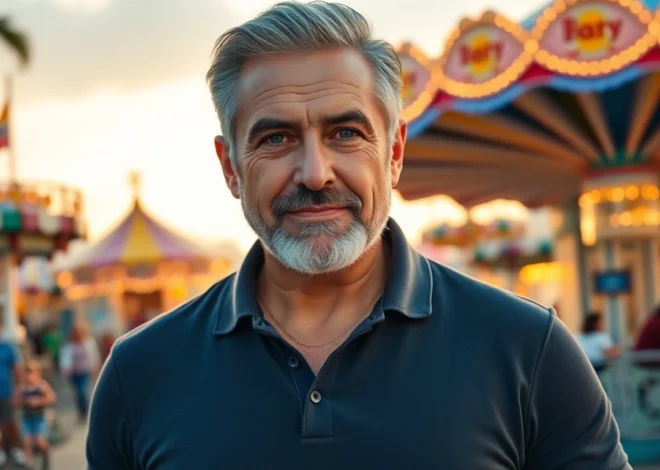
The Ultimate Guide to DILFs: Exploring the Appeal of Mature Men in Popular Culture and Internet Trends
Introduction to the DILF Phenomenon
The term DILF, an acronym standing for “Dad/Daddy I’d Like to F*”, has become a prominent fixture in contemporary pop culture, internet slang, and social conversations. Originally emerging in the early 2000s, this colloquial expression describes an older, mature man who exudes physical attractiveness and sexual appeal, regardless of whether he is a biological father. Unlike the more widely known dilf crushon.ai page, which delves into the cultural and psychological facets of the term, the concept of DILF is both humorous and affectionate, often used as a compliment or playful tease. Its emergence coincided with the rising popularity of similar terms like MILF, which gained mainstream recognition through movies and TV shows, paving the way for DILF to enter the lexicon of flirtation, admiration, and meme culture.
The origin of the term is somewhat informal, rooted in internet humor and adult culture, but it has since been embraced across various media platforms. While the term can be used humorously to poke fun at the idea of mature attractiveness, it also carries a sense of genuine admiration for older men who embody strength, confidence, and charisma. As society increasingly values diverse notions of masculinity and attractiveness, DILF has evolved from an inside joke to a symbol of mature appeal that resonates with a broad audience.
Comparison with MILF and Cultural Significance
To understand the cultural significance of DILF, it’s essential to compare it with its counterpart, MILF—an abbreviation that stands for “Mother I’d Like to F*”. While MILF became popularized in the early 2000s, especially after the release of the American Pie film franchise, DILF gained traction shortly thereafter, often in a humorous or respectful tone. Both terms highlight societal fascination with attractiveness beyond youth, emphasizing the allure of maturity and experience.
Historically, media has often portrayed younger women as objects of desire, but the emergence of DILF signifies a shift toward appreciating older men for their rugged charm, confidence, and life experience. The cultural significance of DILF extends beyond mere physical attraction; it encompasses themes of masculinity, status, and the appeal of maturity. Many see DILFs as embodying qualities like stability, strength, and leadership—traits that become increasingly attractive as men age.
This cultural shift reflects broader societal changes, including a greater appreciation for diverse expressions of masculinity and aging. The term DILF also challenges traditional stereotypes that associate attractiveness exclusively with youth, promoting a more inclusive view of male desirability that celebrates maturity and life experience.
DILF in Popular Culture
Notable Characters and Their Impact
One of the most intriguing aspects of the DILF phenomenon is its presence in popular culture, often through fictional characters that embody the qualities associated with the term. A prime example is Daddy Halsin from the acclaimed role-playing video game Baldur’s Gate. Fans affectionately dubbed him “Daddy Halsin” due to his strong, protective, and commanding personality, which aligns perfectly with the archetype of a mature, attractive man. His appearance and demeanor have made him a favorite among gamers, who often refer to him as a DILF in online communities and fan discussions.
This nickname underscores how fictional characters can influence popular perceptions of attractiveness. Daddy Halsin’s persona combines elements of masculinity, nurturing strength, and authority, making him an ideal candidate for the DILF label in the gaming universe. Such characters help solidify the idea that attractiveness is not solely reserved for youth but also for those who demonstrate confidence, wisdom, and physical prowess.
Television and Film Portrayals
In mainstream media, DILF characters have increasingly appeared in television series and movies, often to add humor, sex appeal, or depth to storylines. An iconic example is Fred Andrews from the Netflix series Riverdale, who has been widely recognized by fans as a quintessential DILF. Fred, played by Luke Perry, exudes a rugged charm, maturity, and a sense of stability that resonate strongly with viewers. His character’s portrayal as a caring yet strong father figure amplifies the DILF appeal, blending attractiveness with a nurturing personality.
Similarly, the 2009 film American Pie Presents: The Book of Love introduced Rob’s father as a DILF character, playing on the comedic potential of older men being sexually desirable. These portrayals often straddle the line between humor and admiration, reflecting society’s growing acceptance of mature masculinity as an attractive trait.
Impact on Audience Perceptions and Stereotypes
The portrayal of DILF characters in media influences audience perceptions, challenging stereotypes that associate attractiveness solely with youth. Instead, these characters exemplify qualities such as confidence, charisma, and physical appeal that transcend age. The recognition of DILF characters in popular culture also fosters a broader conversation about masculinity—one that celebrates strength, maturity, and emotional depth.
This shift helps dispel outdated notions that aging diminishes desirability, instead positioning mature men as equally, if not more, attractive than their younger counterparts. The portrayal of DILFs in media thus contributes to a more inclusive and diverse understanding of attractiveness and masculinity.
Internet and Meme Culture
DILFs of Disneyland Instagram Account
The internet has played a pivotal role in popularizing DILF culture, particularly through social media platforms like Instagram. One notable example is the DILFs of Disneyland Instagram account, which boasts over 300,000 followers. This account shares candid photos of fathers, older men, and mature men enjoying family outings at Disneyland, often highlighting their attractiveness, confidence, and charm.
This social media phenomenon combines humor, admiration, and a sense of community among followers who appreciate mature masculinity in everyday settings. The account challenges stereotypes by showcasing real-life men who embody the DILF archetype—fun-loving, confident, and attractive—while engaged in wholesome family activities. It also humanizes and celebrates older men, emphasizing that attractiveness is not limited to youth or conventional standards.
Reddit and Viral Memes
The subreddit r/DILFs has emerged as a hub for NSFW content, memes, and discussions about the appeal of mature men. With nearly 100,000 members, this online community fosters a space where fans share images, stories, and appreciation for DILFs worldwide. The subreddit often features humorous and explicit content, reflecting the modern internet’s blend of admiration and sexualization of older men.
Viral memes related to DILF culture often parody or celebrate the archetype, making it a staple in online humor. These memes serve to normalize the attraction to mature men, challenging ageist stereotypes and emphasizing that desire can be ageless. Social media trends, including TikTok videos and Twitter threads, further amplify the DILF phenomenon, making it accessible and relatable to a global audience.
The Sexualization and Appreciation of DILFs
Adult Content and Search Trends
The popularity of DILF as a search term has skyrocketed in recent years, especially within adult content platforms and search engines. It has become a widely used tag in pornography and adult media, often associated with videos and images featuring older, attractive men. This trend reflects society’s broader acceptance of mature masculinity as a desirable trait and the normalization of exploring attraction to older men.
Search trend data indicates increased interest, with spikes correlating to popular media portrayals or viral social media content. The term’s rise also signifies a cultural shift where attraction to age-diverse masculinity is openly acknowledged and celebrated. This openness fosters a more inclusive understanding of sexuality, emphasizing that desire is not confined to youth alone.
The Humor, Admiration, and Serious Attraction
While many use DILF humorously or teasingly, there is also genuine admiration for older men who exude confidence, strength, and attractiveness. This duality allows the term to serve multiple purposes—from lighthearted banter among friends to sincere expressions of attraction.
In adult entertainment, the balance between humor and seriousness is evident, with many performers and content creators embracing their DILF status confidently. This evolution reflects a broader societal trend that values maturity and experience, recognizing that attractiveness can be complex and multifaceted.
Cultural Significance and Modern Perceptions
Society’s View of Mature Masculinity
Modern society increasingly recognizes and venerates mature masculinity, viewing it as a desirable complement to youthful attractiveness. The DILF archetype embodies qualities such as confidence, emotional intelligence, and physical strength, which resonate with contemporary ideals of masculinity that go beyond superficial appearance.
This appreciation manifests in media, fashion, and social discourse, where older men are portrayed as desirable, influential, and aspirational figures. The rise of DILF culture underscores a societal shift toward valuing experience, stability, and authenticity in male attractiveness.
The Role of DILFs in Contemporary Media and Dating Culture
In dating apps and online platforms, profiles of older men often highlight features associated with the DILF archetype—maturity, confidence, and attractiveness. This trend reflects changing preferences, where age is no longer a barrier but an asset in romantic and sexual pursuits.
Furthermore, celebrities and influencers embracing their DILF status contribute to destigmatizing aging and attractiveness. They challenge stereotypes and inspire a more inclusive view of who can be considered desirable, enriching the cultural dialogue surrounding masculinity and attractiveness.
Conclusion
The phenomenon of DILF is a dynamic and evolving aspect of modern culture, blending humor, admiration, and genuine attraction. As media representations, internet trends, and social perceptions continue to shift, the appeal of mature men remains a significant and celebrated facet of attractiveness. The rise of DILF culture exemplifies how society is embracing diverse notions of masculinity—where strength, confidence, and experience are just as important as youth and traditional standards.
Looking ahead, the future of DILF will likely involve further integration into mainstream media, more nuanced portrayals, and increased acceptance of aging as an attractive phase of life. The celebration of mature attractiveness not only challenges outdated stereotypes but also enriches our understanding of desirability in a modern, inclusive society. For those interested in exploring this fascinating cultural trend further, the dilf crushon.ai page offers an insightful and comprehensive overview of the phenomenon.
